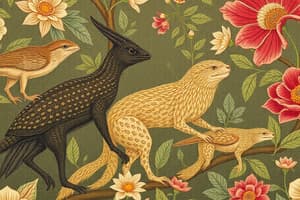Podcast
Questions and Answers
Which process describes a change in the inherited characteristics of a group of organisms over generations?
Which process describes a change in the inherited characteristics of a group of organisms over generations?
- Artificial Selection
- Selective Breeding
- Adaptation
- Evolution (correct)
How do humans influence the traits of organisms in artificial selection?
How do humans influence the traits of organisms in artificial selection?
- By allowing only individuals with specific traits to reproduce. (correct)
- By directly altering the environment to favor certain traits.
- By randomly mutating the genes of the organism.
- By providing specific nutrients that enhance desired traits.
In the context of natural selection, what determines an organism's survival and reproductive rate?
In the context of natural selection, what determines an organism's survival and reproductive rate?
- The organism's physical strength and size.
- The organism's ability to secure the most resources, regardless of genetic traits.
- The organism's ability to adapt its behavior in its lifetime.
- The organism's genetic characteristics that provide an advantage in a particular environment. (correct)
What evolutionary process allows a population to become better suited to its environment over time?
What evolutionary process allows a population to become better suited to its environment over time?
Which of the following provides direct evidence of evolution through artificial selection?
Which of the following provides direct evidence of evolution through artificial selection?
How does fossil evidence primarily support the theory of evolution?
How does fossil evidence primarily support the theory of evolution?
What is the significance of shared characteristics among living organisms in the context of evolution?
What is the significance of shared characteristics among living organisms in the context of evolution?
How do similarities and differences in DNA provide evidence for evolution?
How do similarities and differences in DNA provide evidence for evolution?
What does biogeography study in the context of evolutionary biology?
What does biogeography study in the context of evolutionary biology?
How do common patterns of embryo development support the theory of evolution?
How do common patterns of embryo development support the theory of evolution?
What are fossils?
What are fossils?
Why are transitional fossils important in the study of evolution?
Why are transitional fossils important in the study of evolution?
What is an adaptive trait?
What is an adaptive trait?
What is a common ancestor?
What is a common ancestor?
What is common descent?
What is common descent?
What are homologous traits?
What are homologous traits?
What are vestigial traits?
What are vestigial traits?
What does DNA sequence similarity indicate?
What does DNA sequence similarity indicate?
What does the study of biogeography primarily focus on?
What does the study of biogeography primarily focus on?
What does embryonic development refer to?
What does embryonic development refer to?
Flashcards
Evolution
Evolution
A change in the inherited characteristics of a group of organisms over generations.
Artificial Selection
Artificial Selection
The process by which individuals display specific traits through selective breeding.
Selective Breeding
Selective Breeding
The process by which humans allow only individuals with certain inherited characteristics to mate.
Natural Selection
Natural Selection
Signup and view all the flashcards
Adaptation
Adaptation
Signup and view all the flashcards
Fossils
Fossils
Signup and view all the flashcards
Transitional Fossil
Transitional Fossil
Signup and view all the flashcards
Adaptive Trait
Adaptive Trait
Signup and view all the flashcards
Common Ancestor
Common Ancestor
Signup and view all the flashcards
Common Descent
Common Descent
Signup and view all the flashcards
Homologous Traits
Homologous Traits
Signup and view all the flashcards
Vestigial Traits
Vestigial Traits
Signup and view all the flashcards
DNA Sequence Similarity
DNA Sequence Similarity
Signup and view all the flashcards
Biogeography
Biogeography
Signup and view all the flashcards
Embryonic Development
Embryonic Development
Signup and view all the flashcards
Study Notes
- Evolution involves changes to the inherited characteristics of organisms over generations.
- Artificial selection occurs as specific traits are displayed through selective breeding.
- Selective breeding is when humans only allow specific individuals with desired inherited characteristics to mate.
- Natural selection refers to the survival of the fittest; organisms with advantageous genetic traits for their environment reproduce at higher rates.
- Adaptation refers to the evolutionary process through which populations better adjust to their environment over time.
- Evidence for species evolution through adaptation has been found via direct observation through artificial selection, fossil evidence, shared characteristics, DNA, biogeography, and patterns of embryo development.
- Fossils are the mineralized remains or impressions of formerly living organisms.
- Transitional fossils display physical characteristics between two known fossils on a family tree.
- Adaptive traits features give a individual improved function in a competitive environment.
- A common ancestor is from which multiple species have evolved.
- Common descent is the sharing of a common ancestor by two or more different species.
- Homologous traits are similar features across species that exist because of common descent.
- Vestigial traits are inherited features from a common ancestor that are no longer used.
- DNA sequence similarity refers to how closely related two DNA molecules are.
- The complete coding sequence for the human gene contains 333 nucleotides.
- Biogeography is the study of the geographic locations of organisms or fossils.
- Embryonic development is the process by which an embryo develops.
Studying That Suits You
Use AI to generate personalized quizzes and flashcards to suit your learning preferences.




